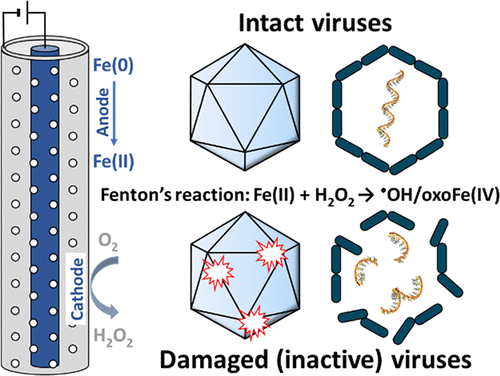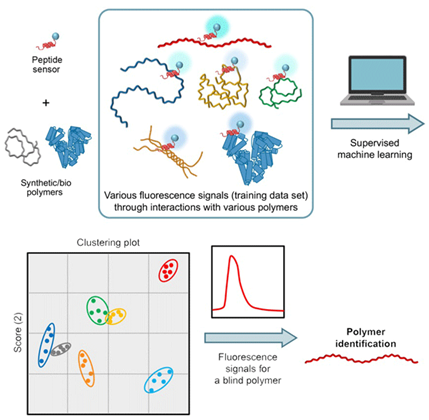Water Tech Spotlight: the latest technology developments in the water industry | December 2021
Technological solutions and innovations are essential to secure a water-wise future. Water Tech Spotlight is a monthly blog which aims to highlight the latest technology developments in the water industry globally. Scroll down to find out more.
1. ZAPPING UNTREATED WATER GETS RID OF WATERBORNE VIRUSES
 Iron electrocoagulation simultaneously removed and inactivated a non-enveloped virus surrogate under slightly acidic conditions. Image courtesy of Kyungho Kim.
Iron electrocoagulation simultaneously removed and inactivated a non-enveloped virus surrogate under slightly acidic conditions. Image courtesy of Kyungho Kim.
Texas A&M researchers have shown that an electrocoagulation method is effective at removing nonenveloped waterborne viruses mainly responsible for gastrointestinal infections. Published in the Journal of Environmental Science and Technology, this experiment used iron electrodes, forging iron precipitates and hydroxyl radicals to capture and inactivate viruses. A novel computational technique was also developed to image viruses in the aggregates. Read more…
2. WORLD`S LARGEST CERAMIC MEMBRANE BIOREACTOR FACILITY TO BE INSTALLED IN SINGAPORE
Following the successful demonstration of ceramic MBR technology at Jurong Water Reclamation Plant (WRP), Singapore’s National Water Agency PUB will equip Tuas WRP with the world’s largest ceramic MBR facility to treat industrial wastewater using two Industrial Liquid Modules (ILMs). With an expected combined treatment capacity of 150,000 m3, this exemplar facility will aid in shortening the water loop and secure a more robust and resilient water supply for Singapore. Read more…
3. COLD ANAEROBIC TREATMENTS TO SHAKE UP WATER SECTOR ENERGY USE
A multi-institutional collaborative project led by Thames Water recently kicked off to decarbonize wastewater treatment thanks to innovative cold anaerobic processes. This membrane-free cold process will be deployed at mobile pilots to investigate its ability to remove nutrients and recover resources under different wastewater strengths. This plan will foster sustainable resource recovery, reduce sludge production, energy consumption and the carbon footprint of wastewater treatment plants. Read more…
4. AUTONOMOUS INSPECTION ROBOT FLEXIBLY NAVIGATES THROUGH WATER PIPES
Award-winning SubMerge Robot recently won the Aquatech Innovation Award. The autonomous robot was developed by a consortium of Dutch water utilities. Smoothly patrolling pipes, this rechargeable robot can detect leaks, corrosions, and map pipe networks to create a digital twin, using a camera, ultrasonic sensor, hydrophone and positioning algorithm. This smart robot, pictured in the main photo of this blogpost, is certainly an ally for water utilities striving to improve network surveillance and asset management. Read more…
5. FITNESS TRACKER FOR WATER PIPES
The Critical Infrastructure Pipeline Protection System® (CIPPS®), jointly incubated by United Utilities and Datatecnics in England, can dynamically track pipeline deterioration. This innovative technology uses data from tiny sensors assessing the expansion and contraction of pipers in real time to work out how ‘healthy’ a pipe is. Read more…
6. NEW POLYMER DETECTION METHOD TO TURN THE (PEP)TIDE IN THE FIGHT AGAINST WATER POLLUTION
 Schematic illustration of the Identification of water-soluble polymers through discrimination of multiple optical signals from a single peptide sensor, Image courtesy of Tokyo Tech News.
Schematic illustration of the Identification of water-soluble polymers through discrimination of multiple optical signals from a single peptide sensor, Image courtesy of Tokyo Tech News.
Water-soluble synthetic polymers substantially contribute to marine pollution and wreak havoc on water and soil as they are very difficult to remove using common filtering techniques. Researchers from the Tokyo Institute of Technology have rolled out an unconventional peptide sensor to detect water-soluble polymers in wastewater through peptide-polymer bonding coupled with machine learning algorithms. Published in the ACS Applied Materials and Interfaces, this is a step forward for innovations aimed at protecting marine environments. Read more…

